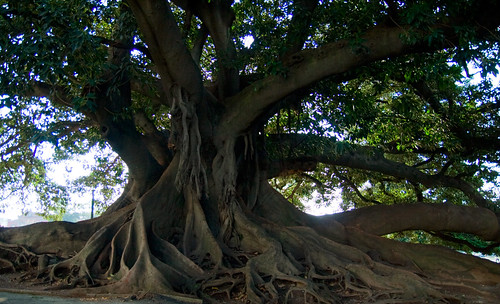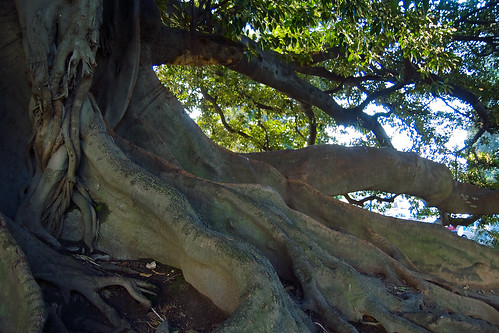
A number of the plazas and parks have these tall trees with branches that twist and curve. These trees remind me of the Live Oaks from central Texas. Not sure what they are called, but they give the parks and plazas a wonderful romantic feel.

I also like the Ombú tree. There are quite a number of these large Banyan-like trees around the city. I believe they are native to the Pampas of South America. Buenos Aires Daily has a nice post about the one in Plaza Congreso
Although, I think the one in front of Le Biela cafe in the Recoleta rivals the one in Congreso as the biggest tree in the city.

Unlike the first trees above, it's the roots of this tree that twist and curve in a sinister like fashion straight out of horror story. Notice the hand-like root in the lower left. It's just waiting to pluck an innocent child into its bough.
That should put you in the Halloween spirit.





8 comments:
Awesome pics! Looking forward to visiting you guys.
Wow, this is an awesome blog and your story and pics are great. I hope it's going well for you down there.
Blake
Can I ask what kind of camera you're using? I love your pics.
Little Fuse...I'm using a canon 30d. Mainly my Tamron 17-50mm wide angle zoom lens. It is best for travel.
Thanks Blake! Glad you like it.
Mark... Can't wait to see some old faces from home. Go ahead and book the trip!
hi yes thats a magnificent tree native to argentina as well as a couple surrounding areas it was planted by carlos thays a landscape architect from paris who really made buenos aires and towns all over argentina the beautiful places that they are from about 1870 to `1900 something he designed planted the parks in belgrano retiro downtown etc and all over mendoza cordoba introduced the stree trees etc anyway tipu tree is wonderful almost evergreen disease resistent but for some reason the city seems not to plant it anymore instead they plant horrible ash trees native to the united state hmm david murbach parttime porteno and mgr, rockefeller center gardens division
Scientific: Tipuana tipu
Common: tipu tree, pride of Bolivia
Family: Fabaceae
Origin: Bolivia
Hardiness zones
Sunset 13-16, 18-24
USDA 9 (may freeze in coldest winters), 10 - 11
Landscape Use: Flowering accent, mesic shade tree, pan-tropic as a landscape tree. Tipu tree is classified as an invasive species in south Africa and is widely planted street tree in tropical cities.
Form & Character: Evergreen to partially deciduous, upright and broad, umbrella canopy
Growth Habit: Flat topped to 25', but can eventually reach 50' with equal or greater spread. This tree is much larger when grown in coastal Southern California than in Arizona.
Foliage/Texture: Pinnately compound leaves, 11 to 21 oblong leaflets, light green in color, medium texture
Flowers & Fruits: Yellow to apricot pea shaped flowers, fruit is a samara-like 1-3 seeded winged pod.
Seasonal Color: Flowers in the early summer
Temperature: Hardy to 25oF and shows summer heat stress when grown around built surfaces of concrete and asphalt.
Light: Full sun to partial shade
Soil: Some intervenal chlorosis might occur in alkaline central Arizona soils
Watering: Apply ample regular water in Phoenix. Some drought elsewhere.
Pruning: Elevate canopy base high into inverted vase canopy. Tipu tree tends to form low co-dominant stems that if unpruned might form included bark resulting in catastrophic limb failure. As a result, significant pruning and staking are needed after transplanting.
Propagation: Seed
on the ombu there are a number of great specimans of this shrub like tree around buenos aires they have a big clump like trunk with rounded features dont confuse with the imported ficus (fig family trees) that also dot the city ie banyan trees they also have massive spreading trunk but their trunks and roots are not rounded so much i think one of your pictures is a ficus not an ombu a great stand of ficus is on the downtown side of the little park next to recoleta cemetery as you walk towards the alvear palace hotel for a king like drink in the lobby
Phytolacca dioica commonly known as the ombu
The ombú is a massive evergreen herb native to the Pampas of South America. It is the only tree that grows there, the only one able to survive on the little water available. The tree has an umbrella-like canopy that spreads to a girth of 12 to 15 meters (40 to 50 feet) and can attain a height of 12 to 18 meters (40 to 60 feet). The ombú grows fast but being herbaceous its wood is soft and spongy enough to be cut with a knife. Since the sap is poisonous, the ombú is not grazed by cattle and is immune to locusts and other pests. For similar reasons, the leaves are sometimes used as a laxative or purgant. It is a symbol of Uruguay, Argentina, and of Gaucho culture, as its canopy is quite distinguishable from afar and provides comfort and shelter from sun and rain. david
Ombu is not a tree!
Is the largest herb in the world.
Post a Comment